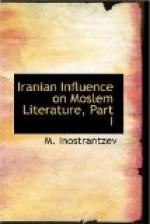Books with the title of Kitab al Mahasin are to be met with in the Fihrist, if not often, several times. A book with this title (77, 21) has been ascribed to the celebrated Ibn Qutaiba. It was composed doubtless after the book of Umar ibn Farrukhan, for Qutaiba flourished at the close of the reign of Mamun and his literary activities could be referred to the ninth century. Qutaiba undoubtedly interested himself in Persian literary materials. Hence it can be concluded that his Kitab al Mahasin was not foreign to the materials and in form could be the first imitation of Farrukhan. Further it is interesting to note that books with this title were attributed especially to Shia authors such as Abu Nadar Muhamed ibn Masud al Ayashi who wrote Kitab al Mahasin al Akhlak or a book of good morals (195, 10) and Abu Abdullah Muhammad ibn Khallid al Barki who wrote Kitab al Mahasin (2213-4, also 7-9). And the interest of Shia authors in Persian tradition was unquestionable. A book with the same title of Kitab al Mahasin is ascribed to a certain Ibn al Harun, (148, 17) an author who has been assigned in the Fihrist a place among the writers on Adab and as responsible for a book called Kitab al Adab. Now the discussion of Adab as we said above is intimately connected with Persian tradition. And this tradition probably survived in the books which had for their theme “the good qualities of Adab."[1] We believe that all these books were devoted to Persian literary tradition, in close relation to which stands the book on “good qualities and manners” mentioned in the Fihrist as translated from the Persian language into Arabic by the man from Tabaristan, Umar ibn al Farrukhan.
[Footnote 1: For instance, Mahasin al Adab of Ispahani, see Brockelmann, Geschichte der Arabischen Litterature I. 351.]
Co-related with these books on “good qualities” stand, in our opinion, the books on “good morals and their opposite,” or “goodness and wickedness,” Kutub al Mahasin wal Azdad, or Kutub al Mahasin wal Masawi. Although in the Fihrist we do not come across books with this title, we have a book so named from the beginning of the tenth century whose author was Ibrahim ibn Muhammad al Baihaki.[1] Under the title of Kitab al Mahasin wal Azdad we likewise possess a work ascribed to Jahiz.[2] Both these books evidently go to a common origin.[3] It is quite possible that antithesis was originally not excluded from these Kutub al-Mahasin, from which were developed a special species of educative treatises,—those on “good qualities and their opposites.” Continuing our comparison with the Parsi literature, we notice that a similar kind of antithesis is most commonly employed there.




